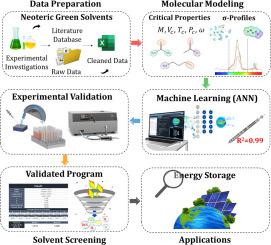Energy Storage Materials ( IF 20.4 ) Pub Date : 2023-04-30 , DOI: 10.1016/j.ensm.2023.102795 Tarek Lemaoui, Ahmad S. Darwish, Ghaiath Almustafa, Abir Boublia, P.R. Sarika, Nabil Abdel Jabbar, Taleb Ibrahim, Paul Nancarrow, Krishna Kumar Yadav, Ahmed M. Fallatah, Mohamed Abbas, Jari S. Algethami, Yacine Benguerba, Byong-Hun Jeon, Fawzi Banat, Inas M. AlNashef

|
Interest in green neoteric solvents, such as ionic liquids (ILs) and deep eutectic solvents (DESs), has increased dramatically in recent years due to their highly tunable properties. One application that has stimulated many experimental studies is their use as green solvents in energy and heat storage. Nevertheless, their theoretically infinite chemical space hinders their practical application and makes it impossible to conclude universal laws regarding their feasibility. Herein, for the first time, we combine molecular modeling and machine learning (ML) to develop a holistic tool that can map the thermal conductivity space of both ILs and DESs to bring their use as green solvents into industrial reality. Two molecular representations were used: the σ-profiles (σp) and the critical properties (CPs). In addition, six ML algorithms were evaluated, and the results showed that artificial neural networks (ANNs) demonstrated fast and accurate predictions of the thermal conductivity space with values of 0.995 and 0.991 using σp and CPs, respectively. The ANNs were further experimentally validated by additional measurements of 5 ILs and 5 DESs, which have not been previously reported in the literature. The results showed an excellent agreement, with deviations of only 2.82% and 2.71% using σp and CPs, respectively. Subsequently, the ANNs were used to successfully screen 1,156 ILs and 1,125 DESs to demonstrate a guided molecular design to achieve different thermal conductivity values. The proposed ANNs were also loaded into an easy-to-use spreadsheet included in the Supplementary materials. This work showcases the power of data-centric modeling for predicting the chemical spaces of ILs and DESs to promote their use as green solvents for various potential applications, including energy storage, fuel cells, and carbon dioxide capture.
中文翻译:

机器学习方法可绘制 2,000 多种新型溶剂的热导率,用于绿色储能应用
近年来,由于离子液体 (ILs) 和低共熔溶剂 (DESs) 等绿色新型溶剂的高度可调性,人们对它们的兴趣急剧增加。激发了许多实验研究的一项应用是它们在能量和热量储存中用作绿色溶剂。然而,它们理论上无限的化学空间阻碍了它们的实际应用,并且无法得出关于它们可行性的普遍规律。在此,我们首次将分子建模和机器学习 (ML) 相结合,开发出一种整体工具,可以绘制 ILs 和 DESs 的热导率空间,将它们作为绿色溶剂的用途带入工业现实。使用了两种分子表示:σ-分布 ( σ p) 和关键属性 (CP)。此外,对六种 ML 算法进行了评估,结果表明人工神经网络 (ANN) 展示了对热导率空间的快速准确预测分别使用σ p和 CPs得到 0.995 和 0.991 的值。通过对 5 个 IL 和 5 个 DES 的额外测量进一步对 ANN 进行了实验验证,这在以前的文献中没有报道过。结果显示出极好的一致性,使用σ p时的偏差仅为 2.82% 和 2.71%和CP,分别。随后,使用 ANN 成功筛选了 1,156 个 IL 和 1,125 个 DES,以证明引导分子设计可实现不同的热导率值。拟议的 ANN 也被加载到补充材料中包含的易于使用的电子表格中。这项工作展示了以数据为中心的建模在预测 ILs 和 DESs 的化学空间方面的力量,以促进它们作为绿色溶剂用于各种潜在应用,包括储能、燃料电池和二氧化碳捕获。

























 京公网安备 11010802027423号
京公网安备 11010802027423号